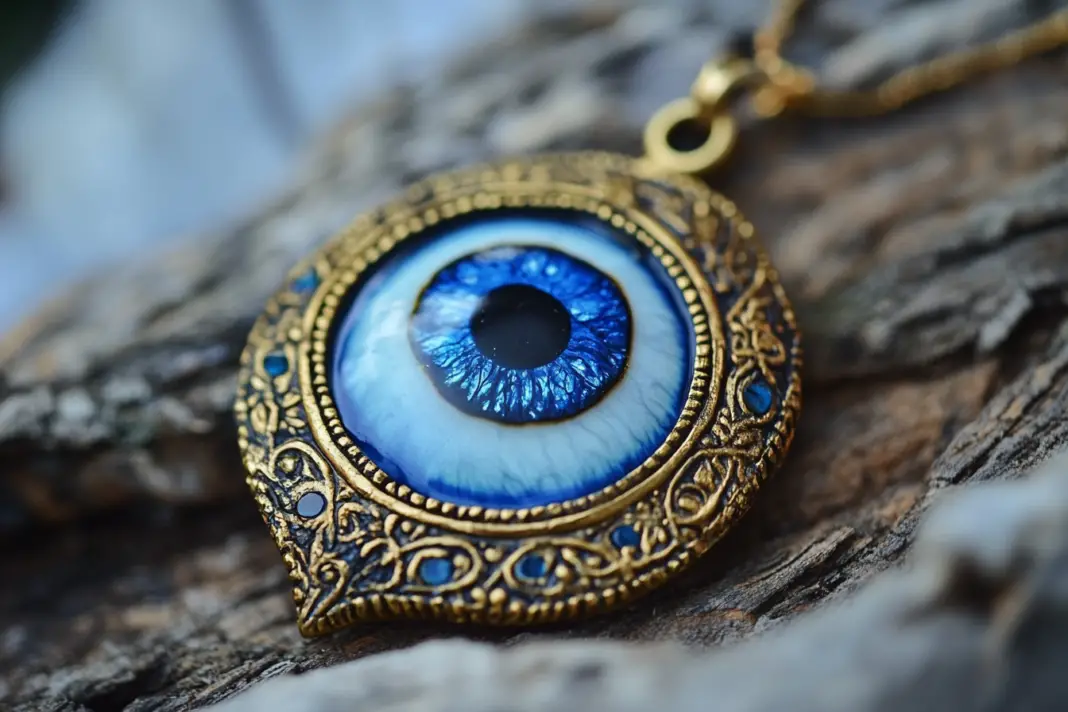From ancient civilizations to modern fashion statements, the evil eye has maintained its mystifying presence across millennia. This powerful symbol, originating over 5,000 years ago in Mesopotamia, continues to captivate people worldwide with its deep cultural significance and protective properties. Beyond its striking appearance lies a fascinating history of human beliefs about envy, protection, and the enduring power of a single glance.
Ancient origins of the evil eye belief
The story of the evil eye begins in the cradle of civilization – ancient Mesopotamia. This belief system emerged from humanity’s earliest attempts to explain misfortune and protect themselves from harm. As trade routes expanded and civilizations interacted, the concept spread across continents, taking root in various cultures from the Mediterranean to South Asia.
In ancient Greece, philosophers and scholars attempted to rationalize the mechanism behind the evil eye. They proposed that the eyes could emit powerful rays that could affect others, a belief that aligned with the ancient Greek understanding of vision and light. This scientific approach to a supernatural concept demonstrates how deeply embedded the evil eye was in ancient thought.
The belief system evolved differently across regions, but its core remained consistent – the idea that a malevolent glare, often motivated by envy, could cause misfortune, illness, or injury. This universal human experience of feeling vulnerable to others’ negative intentions helped cement the evil eye’s place in cultural consciousness.
Archaeological evidence reveals that protective symbols and amulets against the evil eye were among the earliest forms of jewelry and decoration. These artifacts provide valuable insights into how ancient societies dealt with their fears and developed complex systems of protection against supernatural threats.
The psychology behind the evil eye curse
The concept of the evil eye taps into fundamental aspects of human psychology, particularly our relationship with envy and social dynamics. When someone achieves success or happiness, they might feel vulnerable to others’ jealousy, leading to a need for protective measures. This psychological mechanism has helped societies manage social tensions and promote modest behavior.
Modern psychology recognizes how the evil eye belief system serves as a social regulatory mechanism. By acknowledging the potential negative consequences of excessive pride or boasting, communities maintain social harmony and reduce interpersonal conflicts. This understanding helps explain why the belief has persisted across millennia.
The fear of the evil eye can influence behavior in both positive and negative ways. While it might encourage humility and consideration for others’ feelings, it can also create anxiety about personal success or achievement. Some individuals might hesitate to celebrate their accomplishments openly, fearing they might attract unwanted attention or envy.
These psychological aspects demonstrate how supernatural beliefs often serve practical social functions. The evil eye concept provides a framework for understanding and managing complex human emotions like jealousy, fear, and the desire for protection from harm.
Protection methods across different cultures
Different cultures have developed unique methods to ward off the evil eye, reflecting their specific traditions and beliefs. In Turkey, the nazar amulet – a blue glass eye – is omnipresent, hung in homes, offices, and vehicles. The distinctive blue color is believed to absorb negative energy and deflect harmful intentions.
Mediterranean cultures often use the hamsa, a hand-shaped amulet that predates both Christianity and Islam. This symbol appears in jewelry, wall hangings, and architectural elements. The protective practices vary significantly across regions, from the burning of rue in Brazil to the use of red string bracelets in Jewish tradition.
In South Asian cultures, black dots are often applied to children’s faces or hidden in their clothing to deflect the evil eye. Greek traditions involve protective rituals using water, oil, and specific prayers. These methods highlight how communities have adapted the basic concept to fit their cultural contexts.
Modern interpretations of these protective methods have evolved to include fashion accessories and home décor items. While maintaining their protective symbolism, these items have become statements of cultural identity and aesthetic preference, bridging ancient traditions with contemporary style.
Religious perspectives on the evil eye
Major world religions have incorporated the evil eye concept into their teachings and practices. Islam acknowledges the reality of the evil eye in various hadith, providing specific prayers and protective measures for believers. The Quran mentions the concept directly, suggesting its significance in Islamic thought.
Judaism also recognizes the evil eye (ayin hara) as a spiritual concern. Traditional Jewish practices include specific blessings and customs designed to avoid attracting the evil eye. The religious significance extends to daily practices, influencing how people discuss good fortune or celebrate success.
Christianity has a complex relationship with the evil eye belief. While some denominations view it as superstition, others incorporate protective practices into their religious traditions. Orthodox Christians, particularly in Mediterranean and Eastern European regions, often combine Christian prayers with traditional evil eye remedies.
Hindu traditions include various rituals and practices to counter the evil eye (drishti). These often involve specific mantras, ritual objects, and protective symbols. The integration of evil eye beliefs into religious systems demonstrates its enduring influence on spiritual thought and practice.
Modern interpretations and fashion trends
In recent years, the evil eye has experienced a renaissance in popular culture and fashion. Designers have incorporated the symbol into jewelry, clothing, and accessories, often mixing traditional designs with contemporary aesthetics. This trend has brought ancient protective symbols into modern wardrobes and homes.
Social media has played a significant role in popularizing evil eye imagery. Platforms like Instagram and Pinterest showcase endless variations of evil eye designs, while TikTok trends have introduced younger generations to its cultural significance. This digital exposure has led to both appreciation and commercialization of the symbol.
However, this mainstream adoption has sparked discussions about cultural appropriation and the preservation of traditional meanings. Many cultural practitioners emphasize the importance of understanding and respecting the deep spiritual significance behind the symbol, rather than viewing it solely as a fashion statement.
The evolution of evil eye imagery in modern contexts reflects broader trends in how ancient symbols adapt to contemporary life. While some worry about dilution of traditional meanings, others see this adaptation as a natural progression that keeps cultural practices relevant and alive.
Scientific studies and skepticism
Modern scientific research has examined the evil eye belief from various academic perspectives. Anthropologists study how this belief system functions within different societies, while psychologists explore its role in human behavior and social interactions. These studies provide insights into the universal human experiences that sustain such beliefs.
Researchers have documented how belief in the evil eye influences social behavior, decision-making, and mental health across cultures. The power of this symbol extends beyond mere superstition, affecting real-world choices and interpersonal relationships.
Skeptics argue that evil eye beliefs represent outdated superstitions that can limit personal growth and create unnecessary anxiety. However, many researchers note that these beliefs serve important social functions, helping communities manage conflict and maintain social cohesion.
The tension between scientific skepticism and cultural belief highlights broader questions about the role of traditional practices in modern society. This ongoing dialogue contributes to our understanding of how ancient beliefs adapt and persist in contemporary contexts.
Impact on personal relationships and success
The belief in the evil eye can significantly influence how people navigate their personal relationships and professional achievements. Many individuals report modifying their behavior to avoid attracting envious attention, sometimes downplaying their successes or keeping good news private. This cultural practice shapes how people present themselves in social situations.
In professional contexts, some people incorporate protective practices into their work environments. Business owners might display evil eye symbols in their shops or offices, believing these will protect their enterprises from misfortune. This demonstrates how traditional beliefs continue to influence modern business practices.
Family dynamics often reflect evil eye beliefs, particularly regarding children’s welfare. Parents might employ various protective measures for their children, from traditional amulets to modern adaptations of ancient practices. These protective instincts reveal how the evil eye belief system addresses fundamental human concerns about vulnerability and protection.
The influence of evil eye beliefs on personal success stories varies widely. While some see it as a limiting factor that promotes excessive caution, others view it as a reminder to remain humble and considerate of others’ feelings. This duality reflects the complex role traditional beliefs play in modern life.
Regional variations and cultural differences
The evil eye manifests differently across geographic regions, each area adding its unique cultural elements to the basic concept. Mediterranean cultures often emphasize blue protective symbols, while South Asian traditions might focus on black or red protective elements. These regional variations reflect local history, available materials, and cultural preferences.
Latin American interpretations of the evil eye (mal de ojo) often focus particularly on protecting children and incorporate specific healing rituals. Middle Eastern traditions emphasize the power of specific verses and prayers for protection. These diverse approaches demonstrate how cultures adapt universal concepts to local needs.
African traditions incorporate the evil eye belief into broader systems of spiritual protection, often combining it with other protective practices. European variations show strong regional differences, from the complex rituals of Southern Europe to the more subtle acknowledgments in Northern regions.
These cultural differences extend to the interpretation of symptoms and remedies. What might be considered a sign of the evil eye in one culture might have different significance in another, highlighting the importance of understanding local contexts when studying this global phenomenon.
Healing practices and remedies
Traditional healing practices for the evil eye vary widely but often share common elements. Many cultures use water as a primary element in diagnostic and healing rituals, sometimes combined with oil, salt, or specific prayers. These practices have been passed down through generations, maintaining their cultural significance.
Specific plants and herbs play important roles in evil eye remedies across different regions. Some communities use smoke cleansing with specific herbs, while others create protective sachets or teas. The variety of healing methods reflects different cultural approaches to spiritual and physical well-being.
Modern practitioners often adapt traditional healing methods to contemporary contexts. Some combine ancient practices with modern wellness approaches, creating new ways to address age-old concerns about negative energy and protection. This evolution shows how traditional practices remain relevant in modern healing contexts.
The transmission of healing knowledge often follows specific cultural protocols, with practitioners learning from experienced healers through apprenticeship or family tradition. This ensures the preservation of traditional knowledge while allowing for adaptation to changing circumstances.
Future perspectives and evolving traditions
As society continues to evolve, the evil eye tradition adapts to new contexts while maintaining its core significance. Digital platforms and social media create new ways to share and discuss these ancient beliefs, potentially reaching audiences who might otherwise never encounter them. This technological integration helps preserve and transmit cultural knowledge to future generations.
Contemporary artists and designers reinterpret traditional evil eye motifs, creating modern expressions of ancient symbols. This creative evolution ensures the symbol’s relevance while raising questions about authenticity and cultural preservation. The balance between innovation and tradition remains a central concern in these developments.
Academic interest in the evil eye continues to grow, with researchers examining its role in modern society from various perspectives. These studies contribute to our understanding of how traditional beliefs adapt to contemporary challenges and maintain their relevance in changing social contexts.
The future of evil eye beliefs likely lies in their ability to address fundamental human concerns about protection, luck, and social relationships. As long as these basic needs persist, the symbol will likely continue to evolve and find new meanings in future cultural contexts.
The evil eye remains a powerful symbol that bridges ancient wisdom with modern concerns. Its enduring presence across cultures and centuries speaks to fundamental human experiences of vulnerability, protection, and the complex dynamics of social relationships. As we move forward, this ancient tradition continues to evolve, finding new relevance in each generation while maintaining its essential role in human cultural expression.

